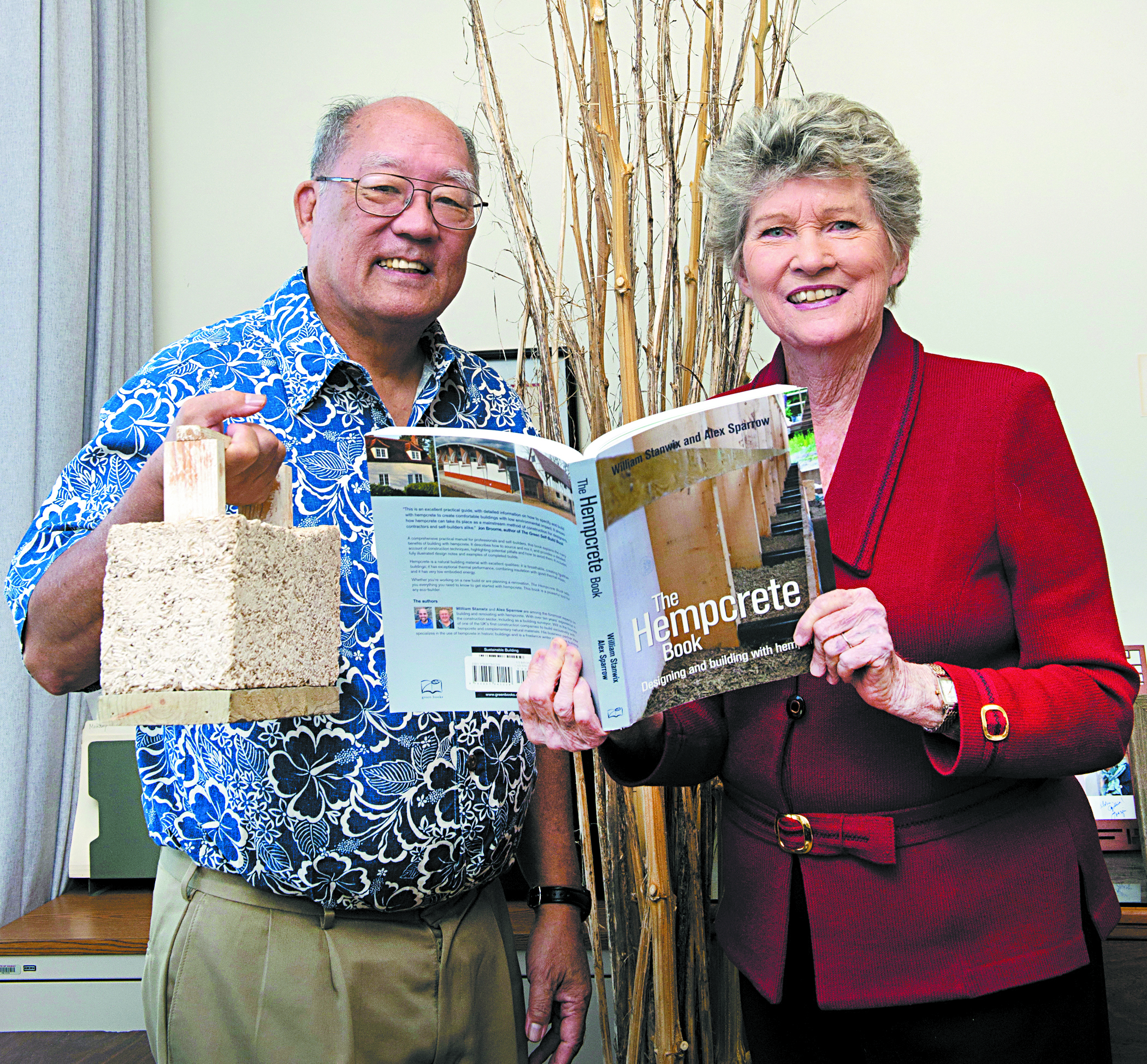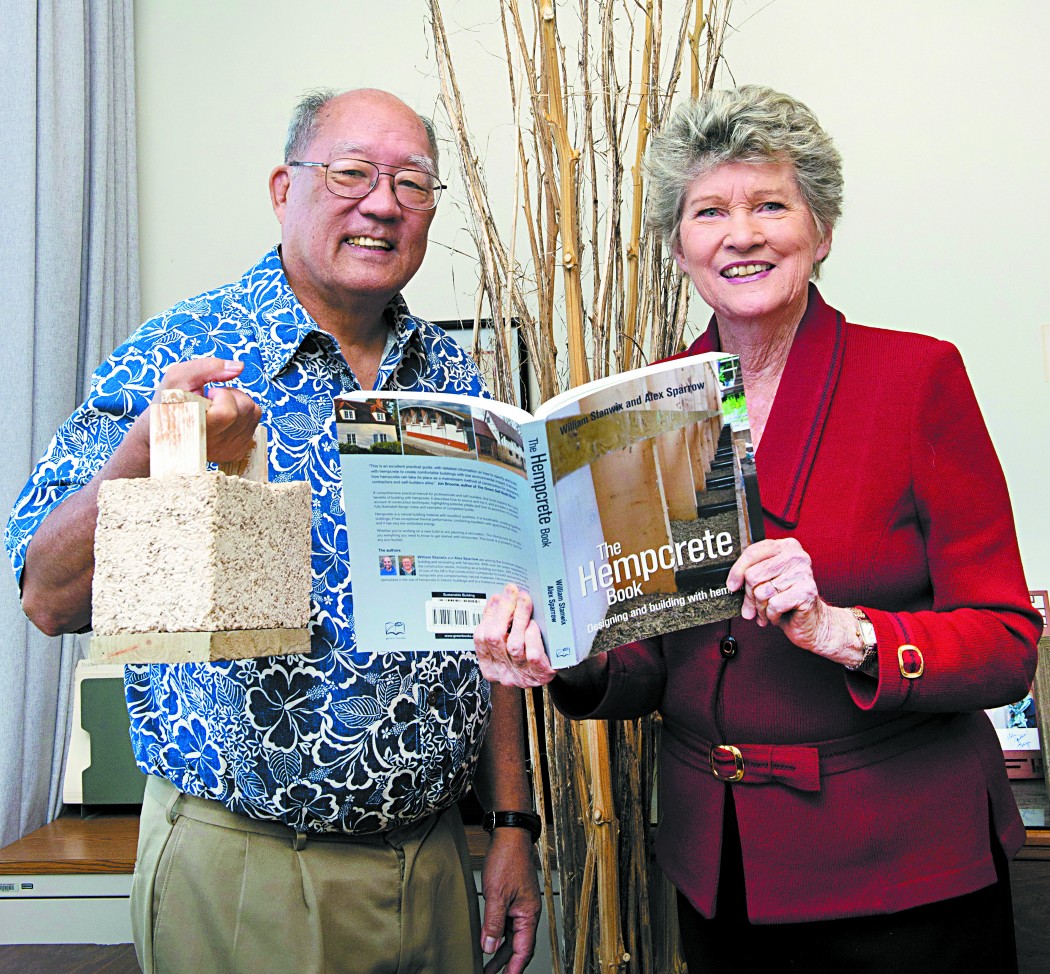High Hopes For Hawaii Hemp

Industrial hemp research project principal investigator Harry Ako, Ph.D., and longtime industrial hemp proponent state Rep. Cynthia Thielen with a hempcrete sample and a book. Behind them are hemp stalks
Hemp seeds, hemp oil, hemp granola — the hemp hype is everywhere today, from food and fashion to cosmetics and construction materials.
Hawaii has high hopes for industrial hemp to fill the void with the looming closure of Hawaiian Commercial & Sugar Company’s (HC&S) 36,000-acre sugar operations on Maui.
The word “high” is an intentional reference to misassociation with marijuana that culminated with a ban in the 1970s, despite hemp farming dating back to our Founding Fathers.
“It has always been a part of our nation,” explains state Rep. Cynthia Thielen, a walking encyclopedia of hemp history. “The Declaration of Independence was written on hemp paper. Betsy Ross sewed the American flag with hemp fabric. George Washington and Thomas Jefferson were both hemp farmers.”
Thielen clearly has pitched this spiel before: “25,000 uses for industrial hemp,” boasts the passionate advocate, “none of which will get you high.”
Thielen had that misconception 20 years ago when her son mentioned hemp as a replacement for sugar. Confused between high THC marijuana and low THC hemp, she reacted by saying “Peter, that’s a drug.”
She then took his response as a personal challenge: “Why don’t you learn about it before you say something like that?”
Thielen toured hemp operations in France, and in her words “found out it made no sense to have this outlawed.” A framed picture in her office of a younger Thielen standing in a French field illustrates how long the lawmaker has championed hemp.
She proudly points out a new photo taken beside hemp planted in Waimanalo last year as part of Hawaii’s Industrial Hemp Research Project. After the signing of the Federal Farm Bill in 2014, state law gave the green light to grow the crop at one site.
If Thielen is considered chief cheerleader, the project’s lead investigator could be called chief critic.
“My hypothesis is these guys talk a lot,” reveals Harry Ako. “You have to be skeptical. That’s your job.”
Talk didn’t excite Ako, but the results did. The plants flourished without herbicides, fertilizer or weeding, and with minimal water. “It gets about desk high, then you go away, come back a week later and it’s a foot taller,” exclaimed Ako. “It grows about a foot a week until it hits an average of 10 feet. You just go, ‘I can’t believe this.'”
Ako discovered that three crops a year could be grown, yielding between 27 and 38 tons dry weight stalks, and two seed crops, producing 2.5 tons of seed per acre.
“You crunch the numbers and say, ‘Whoa, that’s a hell of a lot of food!'” Ako’s expletive is no slip of the tongue. It punctuates the potential he believes that hemp has in Hawaii. He’s referencing one use, as local animal feed, saying, “It would be similar to grass-fed beef, a premium product.”
Eggs provide another golden opportunity. In Ako’s words, “Chickens that are fed hemp seeds lay eggs that contain Omega 3 that are more valuable.”
Holding a block made of hemp and lime, Thielen chimes in, saying, “Hemp-crete is a termite-proof building material that could replace drywall.” At $4,000 to $5,000 for a hempcrete pod, she believes it could be a viable option to house Hawaii’s homeless. Thielen was part of the crew that built the first hemp house on Maui for former Golden State Warriors coach Don Nelson. “It was amazing how fast it went,” she recalls.
Ako experimented with his own homemade hempcrete. The Ph.D. lists several scientific advantages: “It constantly absorbs carbon dioxide from the air. It’s like a plant, so it’ll make the earth cooler.
“No pesticides, because it grows so fast. It grows faster than insects can eat it.”
Dried hemp stalks from the Waimanalo project that tower over the 5-foot-6 Thielen in her office stand as proof. They grew 12-15 feet in 15 weeks.
The state is moving just as swiftly to expand hemp research and move the project to HC&S on Maui. Bipartisan support in the House, spear-headed by Thielen and Maui Rep. Kaniela Ing, could help expedite the transfer, provided the Memorandum of Understanding in the works with the Department of Agriculture and HC&S has no legal hurdles.
“I’m encouraging the DOA to move quickly because some of these sugar workers can stay employed with a crop that can be so beneficial,” stresses Thielen, with an observation. “I am very quizzical about the fact that Hawaii is legalizing eight different locations to grow high-THC cannabis. Right now, we haven’t allowed low-THC hemp. That makes no sense.”
Ako concludes with an observation of his own: “Unless we cultivate a hemp industry, I say this project is worth nothing because the state spent $70,000 on me.”
It’s a strong statement from the scientist, accompanied by a fitting fashion statement: an aloha shirt made from — you guessed it — hemp.




